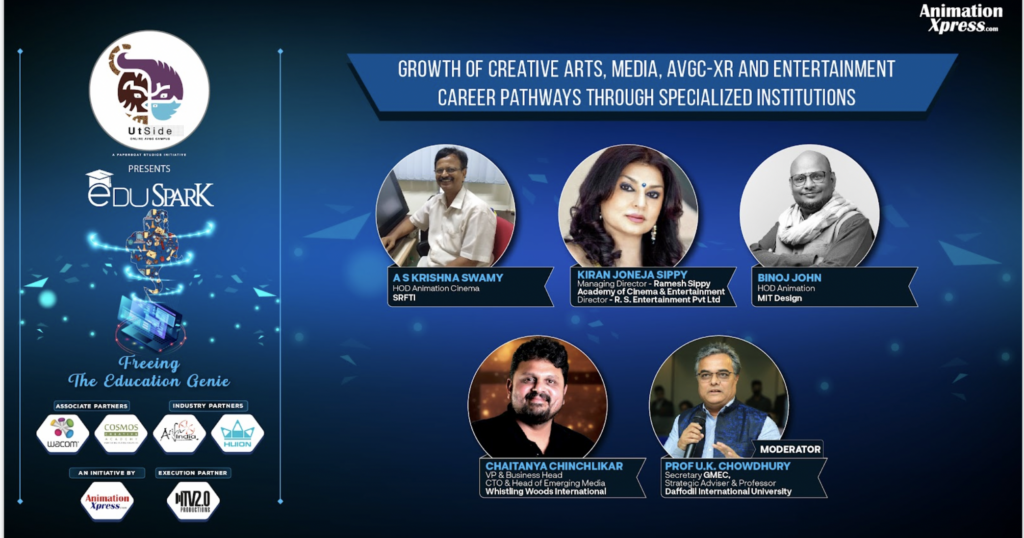The first edition of EduSpark Summit: Freeing the Education Genie, by AnimationXpress.com brought together industry leaders, veteran educators and other stakeholders from the edu-tech ecosystem. The speakers of the ‘Growth of Creative Arts, Media, AVGC-XR and Entertainment career pathways through specialized Institutions’ panel highlighted creativity, convergence, practice, audience sensitivity, revenue sensitivity, technology proficiency, blended learning and project-based learning. They jointly spoke about the awareness that is required to understand the scopes and opportunities in this sector.
The panel discussion mainly tried to highlight how specialized education institutions have been measuring up to the changing situations and coped up post-pandemic, how realistic is the training, how employability is being focused on and much more.
The esteemed speakers included managing director Ramesh Sippy Academy of Cinema and Entertainment (RSACE) and director Ramesh Sippy Entertainment Pvt Ltd Kiran Sippy, Whistling Woods International vice president & business head, CTO & head of emerging media Chaitanya Chinchlikar, MIT Design HOD animation Binoj John and SRFTI HOD animation cinema A S Krishna Swamy. The session was moderated by Global Media Education Council secretary and Daffodil International University, Dhaka strategic adviser & professor Prof Ujjwal K Chowdhury.
Churning out from his elaborate research, Chowdhury pointed out that the AVGC segment of entertainment has been around two billion dollars before the pandemic, which is now close to three and a half billion dollars and will be crossing four billion dollars in 2023. The growth of the sector being phenomenal despite economic hardships is something that excited the panelists.
“Boston Consulting Group says Indian AVGC is almost nine to 10 per cent of the global AVGC market and the potential is to grow beyond 20 per cent and upto 25 per cent by 2025,” Chowdhury said. Based on his own research, he shared that Indian AVGC has hired 50,000 new recruits during the pandemic phase.
He also pointed out that there is a serious resource crunch in talent availability.
“We really need to bring awareness, that there is a lot of work available in AVGC sector. The parents need to be aware of the available job opportunities,” Sippy mentioned during the Eduspark Summit.
According to her, it is still new for the parents to understand the industry. When a child joins these specialized courses he or she is very raw and they just know about visual effects and animation. But they need to know about the entire industry. In Ramesh Sippy Academy of Cinema and Entertainment, they do interviews and counselling to find out their true calling as they don’t want the student to waste years. They are taught about being job-ready and how they can use their creativity to become good filmmakers.
“There is so much need for talents that we can double our intake and still be running short,” she said.
Asked about how are the institutes looking at creating talents in this domain keeping in mind the changes that have been taking place, Swamy who heads the animation department at SRFTI said, “Our institution, unlike the other institutions, produces more filmmakers and our course of education itself is to create filmmakers rather that animators for the industry. We want people who are well versed in all the aspects of filmmaking.”
They try to find people who can be good content creators for the industry. Animation is a new subject for SRFTI and so far two batches have convocated. Even before they completed their course they were hired by companies in Mumbai.
The module at RSACE also trains students to think creatively and become filmmakers rather than just technicians. They learn every aspect of filmmaking while at the institute. When they start practicing different types of software, learn VFX, animation and other things, they actually learn where their talent and interest lie.
As for Binoj John, he said that he doesn’t like the term “industry-ready curriculum”. He prefers calling it “future-ready”, as the future is unpredictable. MIT Design had also started its animation curriculum on similar lines as SRFTI and they have understood the current trend.
“Indian curriculums are mostly rigid and structured. But today children are exposed to social media and whatnot. Considering that, we need to make our universities future-ready,” he said.
John appreciated the new guidelines of UGC which allows institutes offering online classes to source around 40 per cent of course content externally. This allows students to learn from international faculty. MIT Design will take a lead in providing a flexible curriculum to the stakeholders. His inputs made Chowdhury point out the importance of blended learning with hands-on training as well online methodologies.
Asked what WWI is doing differently for the AVGC education, Chinchlikar who is a veteran in the AVGC industry said, “If you look at the 16-year journey of WWI, three years before that when we were planning our academics we started off approaching animation as another tool pipeline for audio-visual narrative storytelling. So you have live-action and animation, just the tools are different.
Just like you have skill-set development in a live-action film, we have a similar skillset developing in animation, whether it is lighting, production design, etc.”
He pointed out that everyone must start talking about gaming as well. If one looks at the US gaming market, it is larger than Hollywood, the American television and music industry put together. Indian gaming industry also has a similar kind of potential.
He said that in order to understand the multidisciplinary aspect of gaming, it is important to borrow from the field of cognitive science. We are an industry that sells to the mind, hence need to know about it.
Moving further during the discussion of Eduspark Summit 2022, Chinchlikar said that pre-visualisation is a huge area of expertise and there are plenty of opportunities in India and the world. Looking at the evolution of the AVGC industry in India, he feels that the task force that has been set up should have been set up 10 years ago.
Dwelling upon the quality of design thinking and technical soundness, John said that when it comes to animation, according to him, storytelling and technology goes hand in hand. He pointed out the importance of research to understand the audience for whom they are generating the content.



